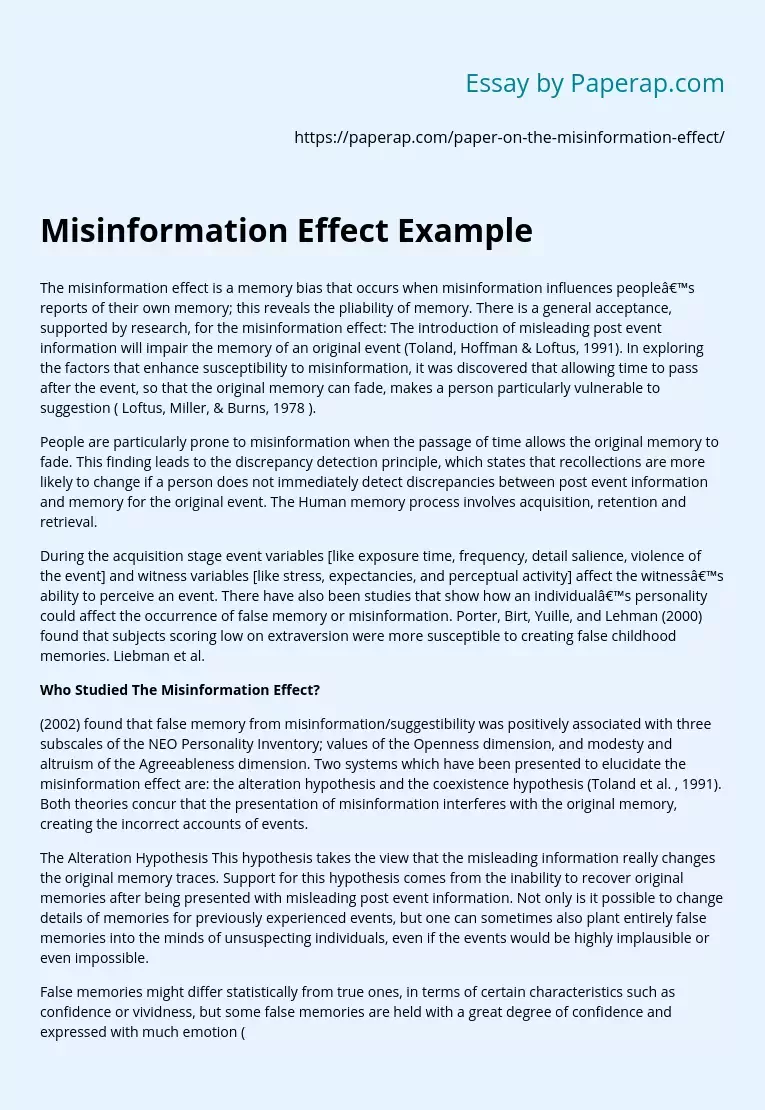Misinformation Effect Example
The misinformation effect is a memory bias that occurs when misinformation influences people’s reports of their own memory; this reveals the pliability of memory. There is a general acceptance, supported by research, for the misinformation effect: The introduction of misleading post event information will impair the memory of an original event (Toland, Hoffman & Loftus, 1991). In exploring the factors that enhance susceptibility to misinformation, it was discovered that allowing time to pass after the event, so that the original memory can fade, makes a person particularly vulnerable to suggestion ( Loftus, Miller, & Burns, 1978 ).
People are particularly prone to misinformation when the passage of time allows the original memory to fade. This finding leads to the discrepancy detection principle, which states that recollections are more likely to change if a person does not immediately detect discrepancies between post event information and memory for the original event. The Human memory process involves acquisition, retention and retrieval.
During the acquisition stage event variables [like exposure time, frequency, detail salience, violence of the event] and witness variables [like stress, expectancies, and perceptual activity] affect the witness’s ability to perceive an event.
There have also been studies that show how an individual’s personality could affect the occurrence of false memory or misinformation. Porter, Birt, Yuille, and Lehman (2000) found that subjects scoring low on extraversion were more susceptible to creating false childhood memories. Liebman et al.
Who Studied The Misinformation Effect?
(2002) found that false memory from misinformation/suggestibility was positively associated with three subscales of the NEO Personality Inventory; values of the Openness dimension, and modesty and altruism of the Agreeableness dimension.
Two systems which have been presented to elucidate the misinformation effect are: the alteration hypothesis and the coexistence hypothesis (Toland et al. , 1991). Both theories concur that the presentation of misinformation interferes with the original memory, creating the incorrect accounts of events.
The Alteration Hypothesis This hypothesis takes the view that the misleading information really changes the original memory traces. Support for this hypothesis comes from the inability to recover original memories after being presented with misleading post event information. Not only is it possible to change details of memories for previously experienced events, but one can sometimes also plant entirely false memories into the minds of unsuspecting individuals, even if the events would be highly implausible or even impossible.
False memories might differ statistically from true ones, in terms of certain characteristics such as confidence or vividness, but some false memories are held with a great degree of confidence and expressed with much emotion (Loftus, 2004). The misleading information destroys and substitutes the original information. This makes the suggested information become an element of the original event memory. The Coexistence Hypothesis This hypothesis proposes that the original and suggested information coexist in memory The original information is still stored but has become inaccessible.
Support for this hypothesis comes from “successful attempts to recover the original information after exposure to misinformation have presumably altered that information in memory” (Toland et al. , 1991). References: Liebman, J. I. et al. (2002). Cognitive and psychosocial correlates of adults’ eyewitness accuracy and suggestibility. Personality and Individual Differences, 33, 49–66. Loftus, Elizabeth F. (2004), Memories of Things Unseen Current Directions in Psychological Science. Volume 13 Issue 4, Pages 145 – 147. University of California, Irvine. Loftus, E.
F. , Miller, D. G. & Burns, H. J. (1978). Semantic integration of verbal information into a visual memory. Human Learning and Memory, 4, 19-31. Porter, S. , Birt, A. R. , Yuille, J. C. , & Lehman, D. (2000). Negotiating of false memories: Interviewer and remember characteristics relate to memory distortion. Psychological Science, 11, 513–516. Toland, K. , Hoffman, H. , & Loftus, E. F. (1991). How suggestion plays tricks with memory. In J. F. Schumaker (Ed. ), Human suggestibility. Advances in theory, research, and application (pp. 235-252). New York: Routledge.
Misinformation Effect Example. (2019, Dec 05). Retrieved from https://paperap.com/paper-on-the-misinformation-effect/

